The following story is dedicated in memory of the eight people who died in a building collapse in East Harlem, when a leak in a natural gas pipeline laid in 1887 exploded on March 10, 2014.
If you’ve read Edith Wharton’s “The Age of Innocence,” you may recall her describing “the one-story saloons, the wooden greenhouses in ragged gardens, the rocks from which goats surveyed the scene” near Mrs. Manson Mingott’s white marble row house on Fifth Avenue.
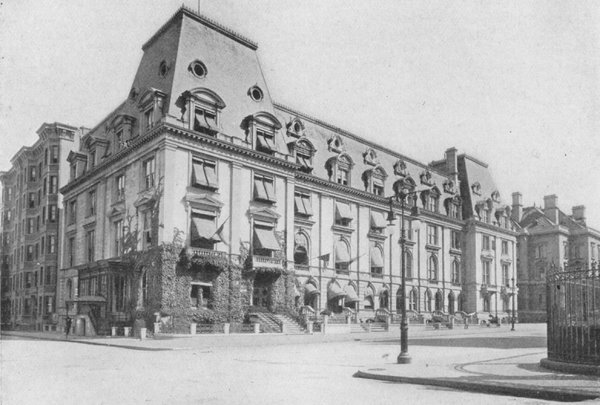
The white marble row house built by Edith Wharton’s great-aunt Mary Mason Jones, looking south from 58th Street in 1899. Photo: Office for Metropolitan History
Although the novel is fiction, much of the story is based on Edith’s own life and experiences in old New York. Mrs. Mingott’s house was based on the real home that Edith’s great-aunt Mary Mason Jones built in 1899. The wooden structures, rocks and goats were also very real in the 1800s.
Walking through the streets of New York City today, it’s hard to believe that only 100 years ago Upper Manhattan was sparsely developed, save for some rickety shantytowns where squatters of mostly Irish or Italian descent lived among the communal goats and chickens.
To be sure, there were a few luxury apartment buildings and tenements here and there – the Dakota at 72nd Street among the most notable – but they were few and far between.

This illustration of the Dakota at 72nd Street from Frank Leslie’s Illustrated Paper, September 7, 1889, depicts the typical squatters’ shantytown of the Upper West Side.
The Goats of Harlem
During the 1800s, the Upper West Side of Manhattan from about 59th Street to Harlem was known as Goat Town or Goatville. Before the extension of the Eighth Avenue elevated railroad prompted new housing construction above Central Park, there was an estimated 15,000 goats in Goat Town.
There were also many goats roaming free on the Upper East Side, especially before some well-to-do residents of Yorkville and East Harlem formed the Anti-Goat Protective Association to expel the goats in 1884.
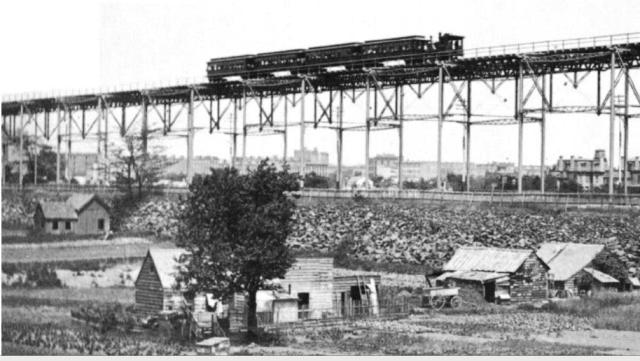
The Eighth Avenue elevated railroad, probably just north of 116th Street. As farmers sold their land, the lots were raised to the new street level.
Although most of Harlem’s goats received bad press for creating a nuisance – like entering a parlor window and devouring wall hangings or trampling flower gardens — the goats in the following story helped the police solve a crime.
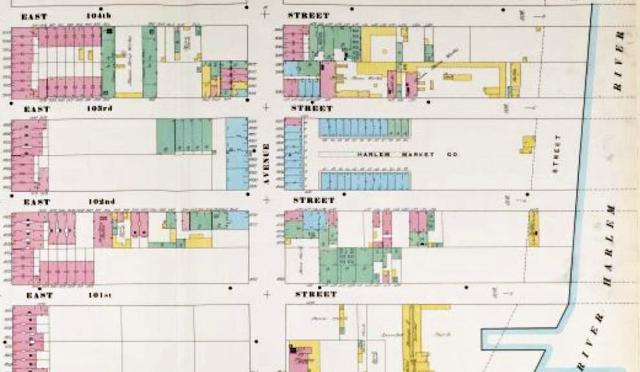
The Harlem Market Company leased 14 acres between 102nd and 103rd Street, First Avenue, and the East River. Existing buildings were converted to booths and new sheds (blue) were constructed to shelter the horse teams.
The Thieves of the Harlem Market
The Harlem Market, one of the greatest open-air markets of its time, was started by a group of men who wanted to provide a wholesale market for small tradesmen and farmers from Westchester County and Long Island. The men, led by M. Michael, J. Wulfhop, E. Williams, and H.C. Koster, established the Harlem Market Company in 1891 with a capital stock of $50,000.
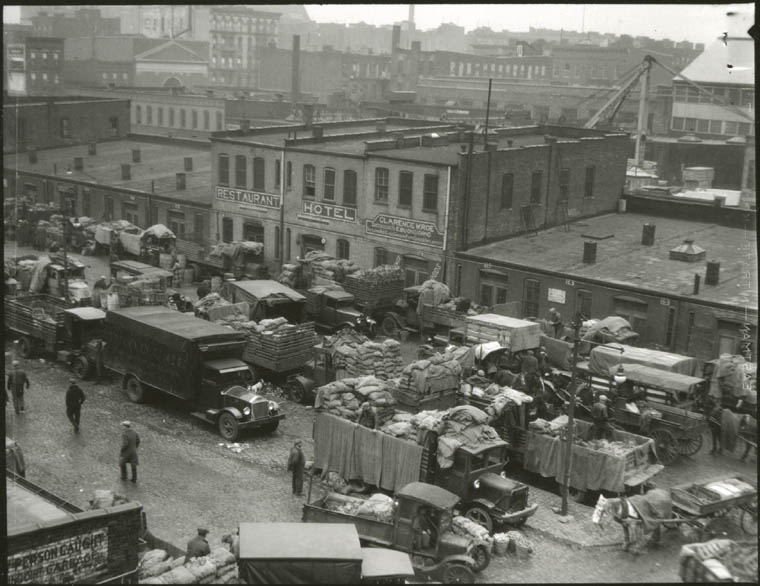
The Harlem Market during the transition from horse-drawn wagons (bottom left) to motorized trucks. New York Public Library, Image ID: 416550
All along First Avenue, blacksmiths and wagon repairmen opened shops to provide new shoes for the horses and fix carriages that suffered damages making the long journey from the farms to the market. Hotels and saloons also sprang up to provide services for the farmers. Hundreds of wagons arrived each day, many of them via steam ferry from College Point, Queens, to 99th Street or the new (1894) Public Services ferry from Edgewater, NJ, to 125th Street.
On November 20, 1897, two men from East 70th Street decided to try their luck at the Harlem Market, which was packed that Friday morning with wholesale wagons and retail push-carts. They loaded their light wagon with some stolen produce, including a crate of onions, a box of oranges, and a basket of string beans. Unbeknownst to them, however, the basket of beans had a hole in it.
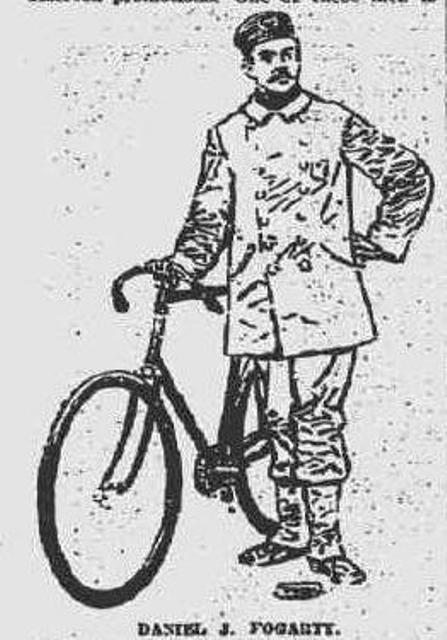
Bicycle Policeman Daniel J. Fogarty of the East 104th Street police station.
When the owners discovered the loss shortly thereafter, they summoned Bicycle Policeman Fogarty. There was no good description of the thieves, so where was he to begin? Perhaps the procession of goats following a trail of beans on the ground held the answer.
Fogarty followed the goats, which led him to the first thief, Joseph Abrams, 26. While the owner was identifying his produce, Abraham Yansky, 22, began to protest the arrest. The victim identified Yansky as Abrams’ accomplice, and he was also arrested. Both men were brought to the Harlem Police Court and held for trial on what was then a pretty stiff bail for stealing some fruit — $200.
The Superhero of East Harlem
Although this story was originally going to be a quick and silly one about some goats, as I dug deeper into the career of Bicycle Policeman Daniel Fogarty, the story got longer – but much more amazing.
During his early career, Policeman Daniel Fogarty was stationed at the East 104th Street police station, which had jurisdiction from East 96th Street to East 116th Street, and from Central Park (and from Sixth Avenue above 110th Street) to the East River, as well as Ward’s Island. It turns out that Policeman Fogarty was a real superhero of East Harlem, a sort of Batman on two wheels in the late 19th century.

The 28th Police Precinct Station House was located at 177 East 104th Street between Lexington and Third Avenues. The five-story station house, which had a two-story prison and lodging house in the rear of the lot, was designed by renowned NYPD architect Nathaniel D. Bush and completed in 1893. It opened on June 28, 1893, and closed in 1974 (then the 23rd Precinct).
The New York press loved writing about his courageous adventures, whether he was being dragged along the ground while trying to stop runaway horses, jumping into the ice-cold river to save drowning victims, or pulling children from harm’s way in the nick of time.

In his 19 years of service, Policeman Fogarty won eight life-saving medals, including a gold medal from Congress for saving a man in the Harlem River. As a friend once told the press, Fogarty had “enough medals to make the German Emperor look like a bloomin’ civilian.”
Here’s just a brief summary of some of his more daring rescues:
January 1896:
Just three months after leaving the postal service to join the police department, Policeman Fogarty rescued a Roman Catholic priest who had fallen from a pier into the icy Harlem River. Shortly after this incident, he jumped into the East River to save Johnnie Crowe, a little boy who had fallen from his mother’s lap into the East River at the Peck Slip pier. The strong current carried them to the Brooklyn Bridge, where a tugboat picked them up.
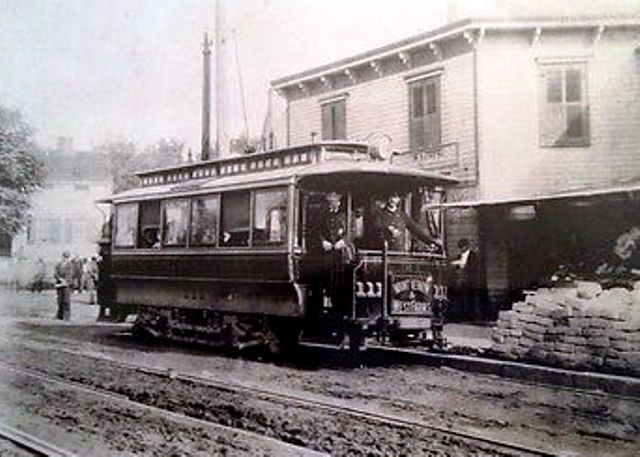
While riding on a West Farms trolley car (like seen here) in July 1896, Policeman Fogarty saw James Harvey fall into the Harlem River. He jumped from the moving trolley, dove off the old Harlem Bridge, and swam 150 feet to rescue Harvey. Fogarty lost two revolvers in the river. (Anyone want to go scuba diving in the Harlem River?)
January 1898:
While cycling down First Avenue around 11 p.m., Daniel heard cries for help coming from the river near 98th Street. He blew his whistle for help, charged into the icy water – striking his leg on a spike – and attempted to rescue William O’Toole, a fireman on the steamship Saratoga who had probably been drinking at Gregory Moser’s barroom. Hearing the struggle, Policemen Darrow and Maguire ambushed the No. 19 horse car and grabbed the reins from the driver’s hands. With some help from a few passengers, they were able to use the cut reins to pull the men from the river.
Asked by a reporter why he thought it was okay for a bicycle policeman to rescue a sailor from the river, Daniel said his book of rules wasn’t handy, so he just guessed it was the right thing to do.
May 1899:
Seeing a wild mustang charging up First Avenue, Fogarty took to the chase. Cheered on by hundreds of spectators, he gained on the horse and caught a rope attached to its halter. He was forced to drop the rope at 101st Street in order to save a small boy who stood in their path. According to the story, Fogarty leaned over his bike, picked up the boy by his collar, and carried him out of harm’s way. Without missing a beat, he continued chasing the horse until he caught him again at 106th Street. The horse was taken to the police stables on East 104th Street.
Father of the Police Drama
When he wasn’t saving women, children, and drunken men, Fogarty was busy volunteering as the first drum major and leader of the new Police Band, which he helped organize in 1903. He also wrote police dramas, which were performed for the benefit of the department relief fund.
In 1905, Fogarty wrote an article suggesting that a film be made on the life of a New York City policeman. He was immediately approached by Frederick Freeman Proctor (F.F. Proctor’s Enterprises), a theatre and vaudeville circuit manager. Commissioner William McAdoo liked the idea of including the New York Police in movie scripts, and so paved the way for the myriad of police movies and TV shows.
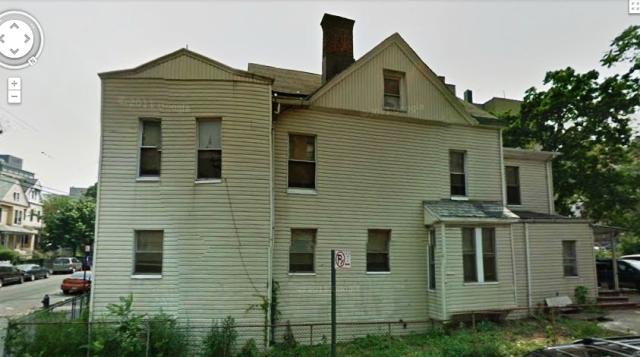
According to the 1920 census, Daniel Fogarty and his wife, Anna, lived in this circa 1901 two-story frame house at 2585 Marion Avenue in the Fordham section of the Bronx with their children Harriet, Harry, Gertrude and Anna. Prior to living here, the family lived on Webster Avenue and then at 375 East 199th Street in the Bronx.
Sergeant Fogarty and Colonel John Jacob Astor IV
In addition to the heroics, Daniel Fogarty was one of the first organizers of the department’s Widows’ and Orphans Relief Fund. As the leader of the Police Band, he thought it would be a good idea for the band to raise money for the wives and families of policemen who were injured or killed in the line of duty.
It was while working with Commissioner McAdoo on this initiative that Fogarty met Colonel John Jacob Astor. Not only did Astor assist in creating the fund, but he also worked with Fogarty to help form the Honor Legion of the Police Department, which was composed of men who rendered distinguished service in time of great danger.
.
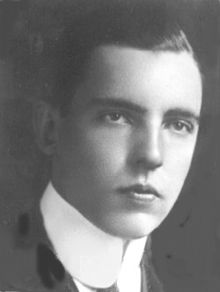
After his father, John Jacob Astor IV, went down with the Titanic, 20-year-old Vincent Astor inherited a massive fortune. The richest boy in the world made headlines when he sold off the family’s slum housing and reinvested in reputable enterprises to help the less fortunate.
When Astor died on the Titanic in 1911, his son Vincent Astor took his place on the fund. Shortly after Sergeant Fogarty retired due to a heart condition in July 1914 (he was then stationed at the East 51st Street Station), Vincent presented him with a $20,000 building on land belonging to the Astor estate at 149th Street and 8th Avenue. Daniel, his wife, Anna, and son Harry opened the Screen Theater – what was then called a “moving picture theater” — in October 1914.

The highly decorated Sergeant Daniel J. Fogarty retired in July 1914 due to a heart condition.
By 1920, Daniel Fogarty was fully retired and had turned the theater business over to his son. He died at home in the Bronx on August 13, 1921. By that time, the goats, the squatters, and the shanties were gone, too.
Today, the land once occupied by the thriving Harlem Market, where Policeman Fogarty fought crime and saved lives on his bicycle, is occupied by the East River Houses, a large public housing development completed in 1941. The former 104th Street Station is still standing, only now it’s owned by Hope Community, Inc., a non-profit housing organization founded in 1968 to “develop, revitalize and beautify East Harlem.”


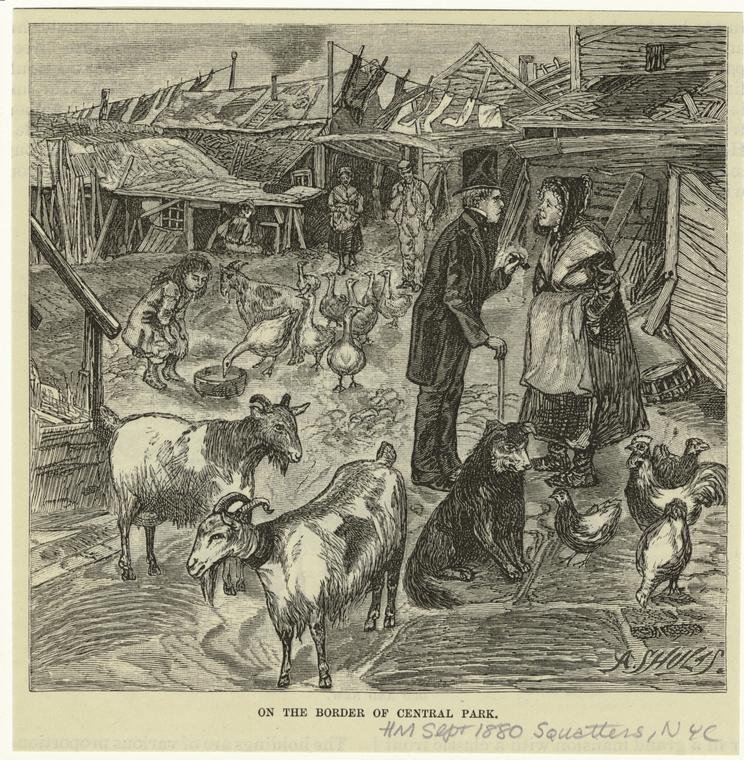


Reblogged this on HarlemGal Inc. and commented:
The following story is dedicated in memory of the eight people who died in a building collapse in East Harlem, when a leak in a natural gas pipeline laid in 1887 exploded on March 10, 2014.
[…] Photo credit: 1) The Eighth Avenue elevated railroad, probably just north of 116th Street. As farmers sold their land, the lots were raised to the new street level. 2) This illustration of the Dakota at 72nd Street from Frank Leslie’s Illustrated Paper, September 7, 1889, depicts the typical squatters’ shantytown of the Upper West Side. (Source). […]